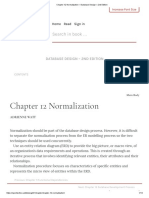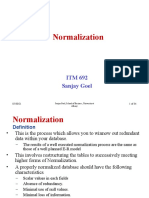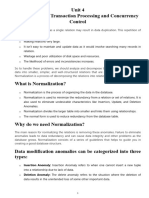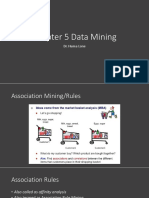0% found this document useful (0 votes)
51 views8 pagesNormalization
Normalization is the process of transforming a database relation into a set of relations that minimize redundancy and dependency to reduce data anomalies. It involves removing repeating groups and partial and transitive dependencies through a series of normal forms up to Boyce-Codd normal form. The document discusses the goals, theory, and anomalies of normalization, and provides examples of transforming relations into first, second, third, and Boyce-Codd normal forms through removing redundancy and dependencies.
Uploaded by
shawonbongshitolaCopyright
© © All Rights Reserved
We take content rights seriously. If you suspect this is your content, claim it here.
Available Formats
Download as PDF, TXT or read online on Scribd
0% found this document useful (0 votes)
51 views8 pagesNormalization
Normalization is the process of transforming a database relation into a set of relations that minimize redundancy and dependency to reduce data anomalies. It involves removing repeating groups and partial and transitive dependencies through a series of normal forms up to Boyce-Codd normal form. The document discusses the goals, theory, and anomalies of normalization, and provides examples of transforming relations into first, second, third, and Boyce-Codd normal forms through removing redundancy and dependencies.
Uploaded by
shawonbongshitolaCopyright
© © All Rights Reserved
We take content rights seriously. If you suspect this is your content, claim it here.
Available Formats
Download as PDF, TXT or read online on Scribd
/ 8























































































